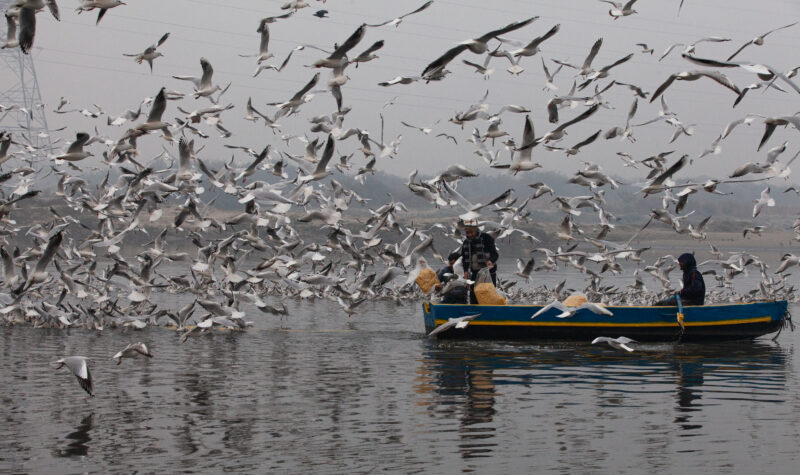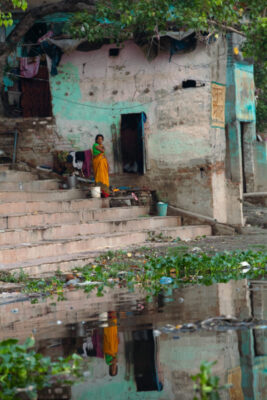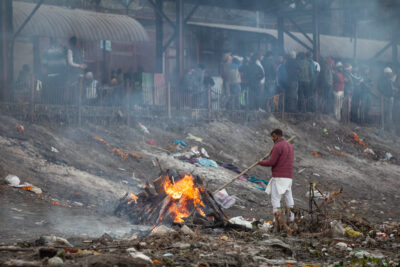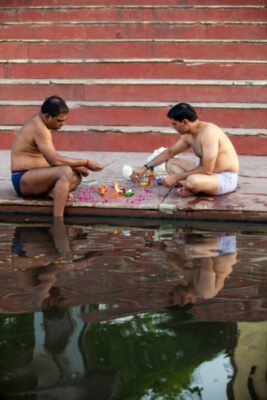
For thousands of years, the Yamuna River has been considered one of the most sacred bodies of water in Vedic (ancient Hinduism) literature and, along with the Ganges, has played a significant role in modern India’s political history, religious culture, and economy. Increasingly, pollution has endangered the Yamuna, making it difficult for residents to use the river for personal hygiene, and challenging its reputation as a source of spiritual rejuvenation. In the exhibition, Chasing a Dying River: Ghat 24 Yamuna, Delhi, India, Praveen K. Chaudhry, professor of Social Sciences, presents a collection of large-scale color photographs that document the humanitarian and social crisis currently visible along the shores of the Yamuna.
Many visitors have come to see the show, and the London School of Economics featured the exhibition on its blog.

Chaudhry spent a month in Delhi studying and photographing the river with Souzeina Mushtaq, PhD, visiting assistant professor of Communication and Media Studies at the School of Journalism at the University of Wisconsin, River Falls. Chaudhry took the images; Mushtaq suggested edits and helped make selections for the show. “I cannot even explain to you how polluted this water is,” Chaudhry says. “I would not even stick my finger in … but then you see people making TikToks on it, people taking their wedding photos.” Toxic foam containing ammonia and phosphates from sewage has materialized on the Yamuna. Mustaq says, “Many Hindu devotees were seen wading through the foam, bathing in the polluted waters.” Even worse, she pointed out, “In 2021 thousands of dead bodies were found floating in the Yamuna river from the deadly second wave [of COVID-19].”
Ironies abound in this fraught situation: “Thousands of dollars were spent to build a controversial Hindu temple that led to the killing and lynching of hundreds of Muslims,” says Chaudhry, who also teaches classes in Global Fashion Management at FIT. “Meanwhile, millions of liters of untreated municipal sewage are directly dumped in one of the most ancient and auspicious rivers for the Hindus.”

Although the river travels 855 miles, this show focuses on Ghat 24, one of the 32 historic stairways on the Yamuna in Delhi. These sanctified waters and the surrounding land now function as a crematorium, a modern highway, a cantilevered subway system, and yet another backdrop for social media influencers. The decline of the Yamuna River’s physical purity is discouraging for those relying on its waters for their basic needs, spiritual celebrations, and the removal of their sins. In a presentation about the show, Mushtaq pointed out that the river’s flowing waters actually have self-cleaning potential: “As the world receded inside their homes due to the COVID-19 crisis, the Yamuna cleaned itself by 33%.” Still, with its stinging depiction of indifference to the environment, the exhibition challenges the viewer to think about their values. How long until nature’s gifts for spiritual purity can no longer transcend contamination? —Ashley Diaz, International Trade and Marketing ’23, with Alex Joseph

Gabrielle Lauricella, campus exhibitions coordinator for The Museum at FIT, curated the show; Dr. Kyunghee Pyun, associate professor, History of Art, served as project advisor.
The exhibition is on display on the fifth floor of the Gladys Marcus Library through August 31.
